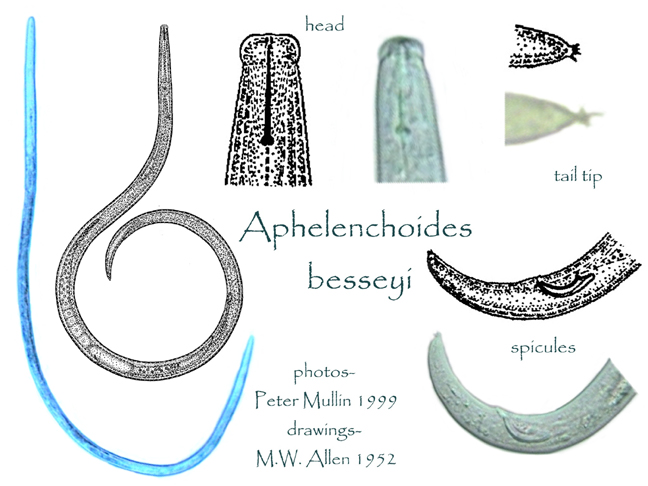Christie, 1942
syn.: Aphelenchoides oryzae Yokoo, 1948
Asteroaphelenchoides (Christie, 1942) Drozdovsky, 1967


|
Photo Gallery- Nine-mile Prairie |
Description (from Hunt, 1993):
Female: Body
slender, straight to slightly arcuate ventrally when relaxed; annules
fine, indistinct, about 0.9um wide near mid-body. Cephalic region rounded,
unstriated, slightly offset and wider than body at lip base; labial framework
hexiradiate, lightly sclerotized. Lateral fields about 1/4th as wide as
body, with four incisures. Anterior part of the stylet sharply pointed,
about 45% of total stylet length, posterior part with slight basal swellings
which are 1.75 um across.
Median esophageal bulb oval, with a distinct valvular apparatus slightly
behind its center. Esophageal glands extending dorsally and subdorsally
for four to eight body widths over intestine. Nerve ring about one body
width behind median esophageal bulb. Excretory pore usually near anterior
edge of nerve ring (anterior to nerve ring in neotype). Hemizonid 11-15
um behind excretory pore. Vulva
transverse, with slightly raised lips. Spermatheca
elongate oval (up to eight times as long as wide when fully distended),
usually packed with sperms. Ovary
relatively
short and not extending to esophageal glands, with oocytes in two to four
rows. Post-uterine sac narrow, inconspicuous, not containing sperms, 2.5
-3.5 times anal body width long but less than 1/3rd distance from vulva
to anus. Tail
connoid
3.5-5 anal body widths long; terminus bearing a mucro of diverse shape
with three to four pointed processes.
Male: About as numerous as females. Posterior end of body curved by about 180 degrees in relaxed specimens. Cephaic region, stylet, and esophagus as described for female: tail conoid, with terminal mucro with two to four pointed processes. First pair of ventrosubmedian papillae adanal, second slightly behind middle of tail and third subterminal. Spicules typical of the genus except that the proximal end lacks an apex and has only a modified developed rostrum. Testis single, outstretched.
Bionomics: Aphelenchoides besseyi is best known as the causal agent of white tip disease of rice. It is a facultative ecto- and endoparasite of the leaves and young tissues of rice, the characteristic symptoms including whitening of the top several centimeters of the leaves, necrosis, distortion and crinkling of the flag leaf and reduction in panicle development. The nematode is seed borne and can survive in a state of anhydrobiosis for several years on stored grain, but much less under field conditions. A. besseyi also attacks strawberry, causing summer crimp, and a number of other plants. It also feeds readily on various fungi. Reproduction is usually amphimictic, the life cycle taking 8 days at 23 C. No development occurs below 13 C, a factor which influences its northerly and southerly distribution.
Distribution: Widely distributed in the major rice growing areas of the world (Africa, Asia, eastern Europe, North, Central and South America, and the Pacific region).
DNA Sequences Obtained
| Specimen: | Collected: |
| 9Mile1-28 SW1-21 | 9 Mile Prairie, Preliminary survey |
| 9Mile 1-28 SW1-16 | 9 Mile Prairie, Preliminary survey |
 |
 |
 |